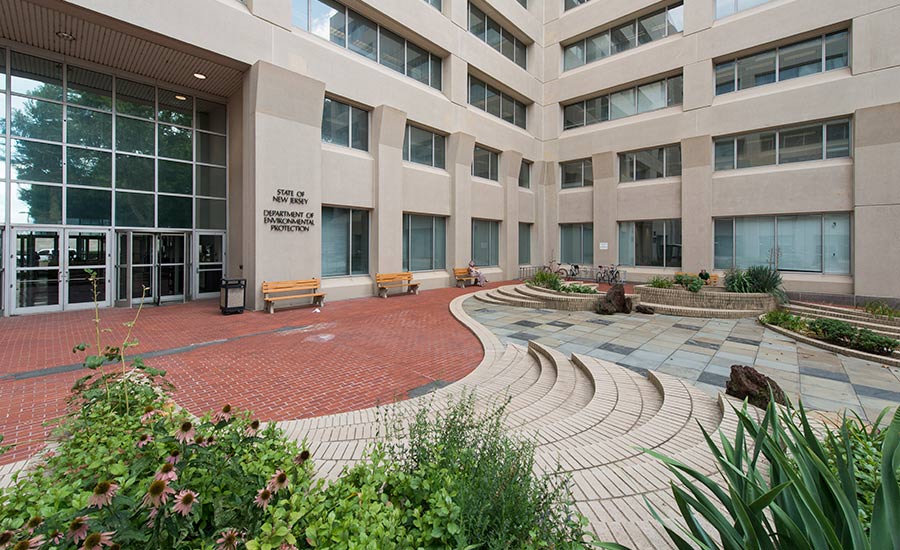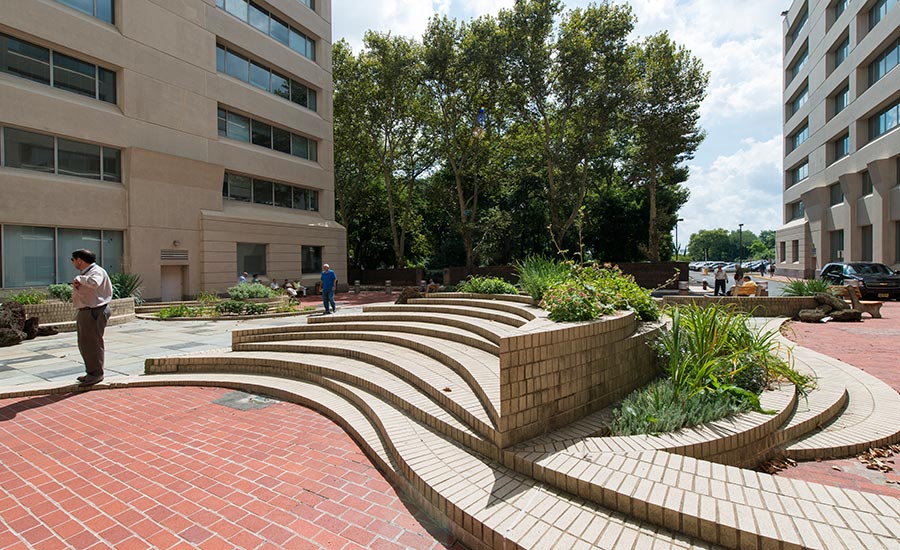“Created as a tangible link to the invisible cosmos, Tacha’s public art provides intuitive access to the larger physical world we inhabit, as well as a much needed place to stop and rest, perhaps even to contemplate.”
History
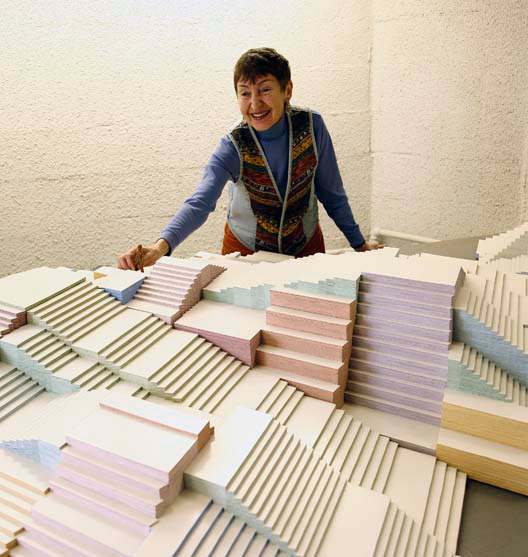
Athena Tacha, photo courtesy Athena Tacha
The work of Greek-American artist Athena Tacha is among the earliest in the field of public environmental sculpture. According to Harriet Senie’s monograph about the artist, Dancing in the Landscape, when Tacha first “began to think about creating art for public spaces in the early 1970s, the contemporary public art revival had barely begun.”[2] This work represents a significant juncture of art and landscape architecture, Senie says:“Tacha’s early ideas about public sculpture were also related to Robert Smithson’s interest in nature and science. But while Smithson and other artists created earthworks as art in nature, Tacha was, from the start, interested in including an element of public use. As someone who ‘experiences the world a lot through body motion,’ she created structures that offered viewers the same opportunity … Tacha provided more than a place to sit; she incorporated a sense of the body moving and at rest that relates more to landscape architecture.”[3]
Tacha, studied sculpture at the National Academy of Fine Arts in Athens, and art history at Oberlin College in Ohio where she received her M.A., before completing a Ph.D. in Aesthetics from the Sorbonne in Paris, France. She produced her first outdoor sculpture for a 1971 exhibition at the Blossom Music Center in Peninsula, Ohio, and her first large-scale outdoor work, Charles River Step-Sculpture for a site along the Charles River in Cambridge, Massachusetts in 1974. Since then her works, which are fashioned from a broad range of materials, including stone, brick, steel, water, plant materials, and contemporary technology, such as her 2009 work at Wisconsin Place in Chevy Chase, Maryland, which incorporates L.E.D. (light-emitting diode) lighting, have been commissioned for sites worldwide.
Tacha’s works are deeply informed by her interest in the sciences. According to the artist “Space, three-dimensionality, is the essential element of sculpture, but matter too … So I started to ask, ‘What is space, what is matter, what is gravity.’ That’s what led me to all the science reading. Concepts of space and matter change constantly, of course. I have to keep up with it, and accordingly, my art changes because of our present perception of space and time and matter and energy and gravity.”[4]

Wisconsin Place, photo © Allen Russ
Many of her pieces explore these ideas, reflecting natural forms, and manipulating the ways that individuals experience space. Tacha’s site-specific works can be divided into two categories, those that explore the ground plane, and those that explore the vertical plane. Steps and terracing feature prominently in a number of her works including; Streams, (1976) Oberlin, Ohio; Merging, (1987) Cleveland, Ohio; and Swan Waves, (1996) Toledo, Ohio. Other frequently used forms include mazes, arcades, colonnades, and slab twists (twisting cantilevered sculptures of stone) – a spiral shape inspired by nature that Tacha uses often.
During the course of her career Tacha won more than 40 commissions for public art, 37 of which were built. These include the artist’s painted corten-steel Curving Arcades (Homage to Bernini), which was completed in 1981 for the University of Arizona’s Tucson campus; Connections, (1992) a terraced landscape of plantings and boulders, in Philadelphia; and Crossings a painted galvanized steel sculpture created in 1982 for a site at the Columbus, Ohio International Airport, but dismantled for a 1988 airport expansion and never reinstalled. This extensive body of works serves as a record, not only of Tacha’s mark on the land, but, as the artist hopes, the imprint that each of her pieces leaves on the people that travel through them: “Since my work needs to be walked on and lived with in order to become fully communicable, it ideally should be located in public places. I would like my art not to be set apart as art, looked at with awe or antagonism, but to exist in the context of daily life. In this way, I would hope that the average person, crossing the work routinely, would absorb unconsciously my message ... I would hope that through my work, as with Indian dance, people's bodies can eventually capture an echo of the rhythms that permeate the universe as I see it – in constant flow.”[5]
THREAT
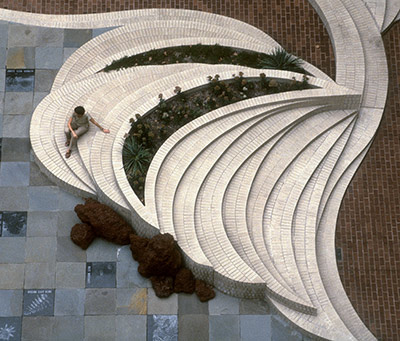
Green Acres, photo courtesy Athena Tacha
Of Tacha’s 37 built works 30 survive, and the future of those remaining is highly variable. This is a reality that many site-specific artists have faced in ensuring the longevity of their pieces. Unlike most paintings and sculpture, which can be moved, site-specific works, like architecture and landscape architecture, are dependent on their surroundings to give them context, and they cannot be moved or altered-in-place without compromising their design intent.
The longevity of these works is dependent on an ongoing commitment and stewardship by their owners. Although Tacha provides instructions detailing the appropriate care needed for each work; the passage of time, budget cuts, austerity measures, and changes in site ownership are all potential contributors to neglect. Unfortunately Tacha’s work and that of other artists have minimal legal protection. The most significant, the 1990 Visual Artists Rights Act (VARA) provides some protections, but has little control over maintenance and/or demolition.
The limitations of VARA became apparent in the case of Tacha’s site-specific work Green Acres. The sculpture, set within a U-shaped courtyard enclosed by the New Jersey Department of Environmental Protection building, was commissioned in 1985 and honors the state’s similarly named land conservation program. In April 2012, the state’s Treasury Department informed Tacha that Green Acres would be destroyed unless the artist removed the work in its entirety and at her own expense. The state planned to replace Green Acres with a rain garden, a move officials said would demonstrate its commitment to the environment. TCLF worked with statewide and national supporters to quickly mount a campaign to prevent demolition – proposing an environmentally friendly alternative, inclusive of a rain garden, to show Tacha’s work could be kept intact. In August 2012, state officials reversed the decision to destroy the piece, although no funding was committed to its restoration.
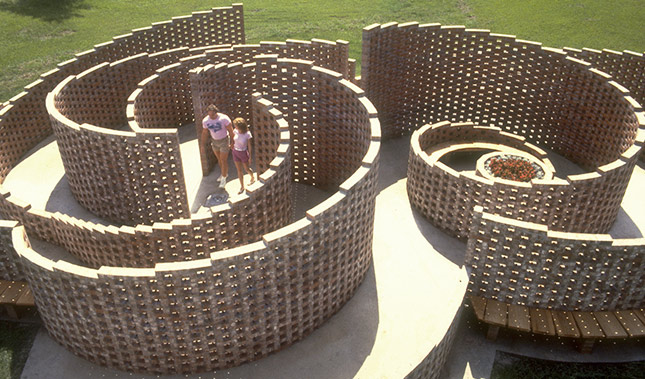
Marianthe, photo courtesy Athena Tacha
Other works by Tacha have not been so lucky. Marianthe, which was completed in 1986 for the University of South Florida in Fort Myers, is considered by Tacha to be one of her most significant works. In 1994 she learned that cracks had developed in the piece and requested that the school make repairs. Instead, the piece continued to deteriorate and in 2000 was demolished by its then owner, Edison Community College – school officials said it had structural defects.
The fate of Green Acres is currently on a similar path. Now two years since the decision to demolish was reversed, a restoration of Green Acres has not been undertaken. Unfortunately, as has been all too common with pieces commissioned by similar public art initiatives, these programs fail to account for long-term maintenance after the artwork is installed.
1 Harriet F. Senie, “Glimpses of Infinity: Nature and Science in Athena Tacha’s Public Art,” Dancing in the Landscape: The Sculpture of Athena Tacha (Grayson Publishing: Washington, D.C., 2000), 12.
2 Ibid, 8.
3 Ibid, 8.
4 Glenn Harper, “Athena’s Other Selves: An Interview with Glenn Harper,” Dancing in the Landscape: The Sculpture of Athena Tacha (Grayson Publishing: Washington, D.C., 2000), 17.
5 Athena Tacha, “Rhythm as Structure,” Landscape Architecture, May 1978, 196-205.


